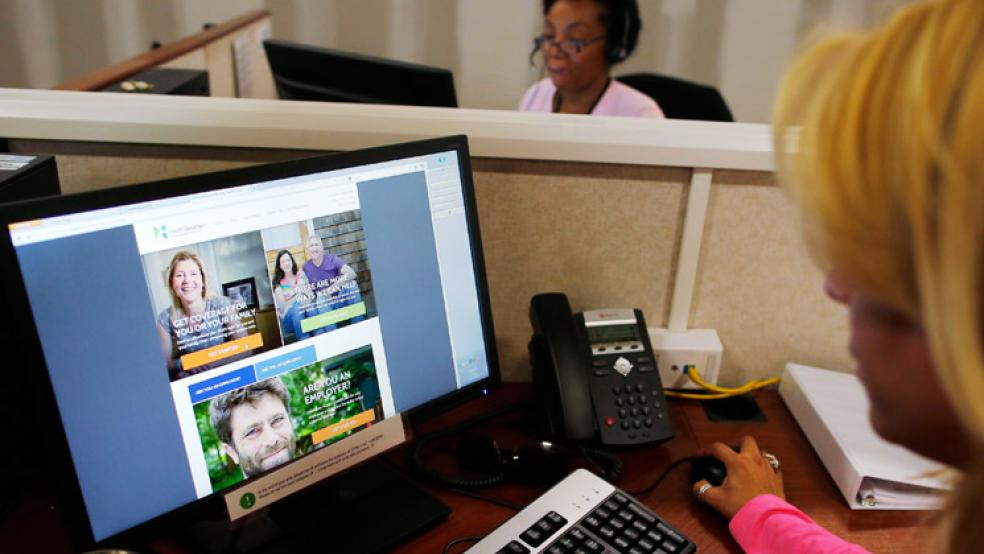Now that the first open enrollment period under the Affordable Care Act is coming to a close, insurers say they are getting a better idea of what to expect next year—and that includes higher premiums.
Early into Obamacare’s troubled launch—plagued with website problems, cancelled plans and numerous delays—several insurers were already warning that the rocky rollout would result in significantly higher premiums in 2015.
Related: Insurers on Obamacare: Expect Premiums to Soar
Aetna CEO Mark Bertolini first raised concerns over a potential rate shock in December, when he told investors that “in some markets,” individual-market premium increases “could go as high as 100 percent.”
Now, other insurance executives are coming to similar conclusions.
The Hill reported Wednesday that one unnamed insurer expects that his company will "triple its rates next year on the Obamacare exchange.”
Still, other industry insiders say it’s too early to tell. Avalere Health’s Vice President Caroline Pearson said “without knowing what age and health status mix plans assumed in their premiums this year, it is hard to predict the impact.”
To be sure, the price of premiums has been trending upward long before the Affordable Care Act. However, those prices could soar even higher due to a combination of new taxes on the health industry, as well as several consequences of the law's troubled launch.
Insurers are required to submit their proposed rates later this spring, so by early fall, we will know what the rates are for next year. In the meantime, it’s important to understand what will factor into next year’s prices.
Here are four new things that could lead to rising premiums:
1. The Mix of Enrollees
Insurers say that people signing up for insurance through the new exchanges tend to be older and unhealthy. This is bad news for the Obama administration, which has stressed that younger enrollees are crucial to making the law work since they offset the costs of insuring older, sicker individuals. Early on, the White House said its goal was to have young people make up about 40 percent of total enrollees. However, the latest enrollment figures through March reveal they only make up about 27 percent of total enrollees.
Insurers have previously sounded alarms that if the administration doesn’t get enough young and healthy people to sign up, a so-called “death spiral” could occur. Though most insurers and even critics of the law don’t think a death spiral will happen, they are concerned that the enrollees—who skew older—will be a factor in raising the cost of premiums next year.
2. Administrative Rule Changes’ Impact Enrollment Numbers
When the president announced that people could stay on their non-ACA compliant policies through 2016, many Americans decided to keep their old plans, even though insurers assumed would buy coverage on the new exchanges. Since these plans are less expensive and tend to be held by younger people, the change could mean that the risk pool will shift further toward older, sicker Americans.
“We’re exasperated,” an insurance executive told The Hill. “All of these major delays on very significant portions of the law are going to change what it’s going to cost.”
3. Adjusted Medical Loss Ratio
The Obama administration is expected to announce a tweak to a provision in the law that sets a minimum medical loss ratio (MLR), Kaiser Health News reported. Under current law, insurers are required to put at least 80 percent of their total premium revenue from individual and small group market plans toward medical payments or consumer rebates, with the rest going to administrative costs and profits.
The whole idea of the law was to limit insurers’ profits and keep premiums stable. However, the rule change would alter that limit and allow insurers to spend more on administrative costs in order to help insurers cope with the rocky rollout.
4. Insurers Underpriced Plans This Year
When insurers set their prices for this year, they had to estimate what the mix of enrollments would look like. Some insurers underpriced their policies, with the intention of raising their rates the second year when they had a better idea of what to expect.
Still, as The New Republic’s Jonathan Cohn notes, “It’s not clear exactly what insurers were expecting in the first place—or how widely spread the anxiety over enrollment patterns is.”
Top Reads from The Fiscal Times:
- Consumers Hit With Surprise Tax in Obamacare Premium
- Obamacare: Obama’s Press Secretary Defends the Indefensible
- Obamacare Victims Are ‘Liars,’ Says Top Democrat





